With Ryzen 5000 alias Cezanne, AMD clearly outperforms its predecessor, the Ryzen 4000 in the notebook, in terms of CPU performance thanks to a higher IPC and more clock speed. If the new Zen 3 CPUs are combined with a gaming graphics chip, Intel is beaten in the notebook. The iGPU is again outdated and AMD is also lagging behind in terms of features.
Table of contents
- 1 5980HS, 5900HX & amp; 5800H for notebooks turn right on
- In theory, faster and more widely available
- Almost identical Zen 3 cores: Now in the notebook
- More CPU clock (and TDP) brings more performance
- Old Vega GPU with less voltage and more clock
- The memory also saves more electricity
- Still only eight PCIe 3.0 lanes for graphics cards
- The APU has grown, but uses the same socket
- when Power consumption closer to Intel
- Model range of AMD Ryzen 5000 Mobile
- 2 Test results and benchmarks
- The test models at a glance
- Benchmarks and hurdles with 35, 42 and 80 watt TDP
- Benchmarks in applications
- Benchmarks in games
- Cezanne compared to desktop CPUs
- 3 Conclusion
- Zen 3 also convinces in the APU
- No progress with the iGPU without AV1 support
- An exciting one Notebook year 2021
Update 06/11/2021 10:00 am
With the Asus ROG Strix G15, the editors now also had a notebook with Ryzen 9 5900HX. Compared to the previously tested mobile Zen 3 CPUs Ryzen 7 5800H and Ryzen 9 5980HS, this 45+ watt CPU offers even higher all-core turbo clock rates (+100 MHz for the 5800H, +300 MHz for the 5980HS) and is positioned exactly in between at the maximum single-core clock.
Threads Base clock Turbo clock Graphics Graphics clock L3 cache TDP Ryzen 5000H Ryzen 9 5980HX Cezanne (Zen 3) 8/16 3.30 GHz 4.80 GHz Vega8 2.1 GHz 16 MByte 45+ watt Ryzen 9 5980HS 3.00 GHz 4.80 GHz 35 watts Ryzen 9 5900HX 3.30 GHz 4.60 GHz 45+ watts Ryzen 7 5800H 3.20 GHz 4.40 GHz 2.0 GHz 45 watts
In the Asus notebook, this processor can also permanently consume significantly more energy than the “45+ watts” in the official specifications suggest. In practice, it is up to 107 watts for a short time in the “Turbo” profile, and around 95 watts in the long term (Ryzen 7 5800H in the XMG Core 17: 80 watts) – the critical temperature threshold of 96 ° would also be higher in the Asus ROG Strix G15 Exceed C and force the CPU to slow down.
ComputerBase has added the test results of the Ryzen 9 5900HX to the article from February. This applies to all app benchmarks as well as the line diagrams for CPU package power, temperature and clock rate. A look at the consumption in the Blender benchmark already shows that the results supplement the content of the original article (Ryzen 9 5900HX in orange).
Package Power (Blender, BMW) 024487296120Watt (W) 171,31925313743495561677379859197103109115121127133139145150 Ryzen 7 4800U, 20W (Yoga Slim 7) Ryzen 7 4800U, 38W (Yoga Slim 7) XM7-10870H, 55/135870 (Core i7-10870H, 55/135870) 45/90W (XMG Pro 17) Ryzen 7 5800H, 45/65W (XMG Core 17) Ryzen 7 5800H, 80/95W (XMG Core 17) Ryzen 9 5980HS, 80/130 W (ROG Flow X13) Ryzen 9 5980HS, 42/65 W (ROG Flow X13) Ryzen 9 5980HS, 35/65 W (ROG Flow X13) Ryzen 9 5900HX 95/107 W (ROG Strix G15)
The combination of the multi Core performance of the Ryzen 9 5900HX and the single-core appearance of the Ryzen 9 5980HS shows in theory the performance of the Ryzen 9 5980HX – this processor is not yet available on the market.
theoretically faster and wider available
Exactly one year after the Ryzen 4000 “Renoir” for notebooks, AMD presented the Ryzen 5000 “Cezanne” at the CES at the beginning of January. And instead of allowing three months to pass between the announcement and the market launch, as last year, things should go very quickly this time: The embargo on tests and sales clearance officially fell at the end of January.
It is no coincidence that AMD tries to set the pace: Cezanne offers processors with six or eight state-of-the-art Zen 3 cores, while Intel only offers four modern cores (Tiger Lake (-H35)) or up to eight old cores (Comet Lake-H) has to offer. Especially in the gaming notebook, the signs with Zen 3 against Skylake are potentially very good for AMD and that should also explain the prioritization of the H- over the U-APU.
In practice, however, there was also a problem this year, because even (pre-series) samples only made it into editorial offices in isolated cases until the end of January – for ComputerBase on the exact day of the embargo. It remains to be seen how it will look against the background of the current cross-sector chip shortage in retail, especially since many Cezanne notebooks will also rely on Nvidia's GeForce RTX 3000 laptop GPUs (test). After all, the first models are already listed in stores.
Two 8-core APUs in the test
In the meantime, ComputerBase was able to take a closer look at two notebooks with two differently specified Ryzen 5000s, both of which are 8-core APUs. The sample provided by AMD with Ryzen 9 5980HS marks the binned flagship in the 35-watt class; it is in the new Asus ROG Flow X13, a 13-inch notebook. The second device is the pre-production model from Schenker, which was already used in the test of the GeForce RTX 3060 laptop GPU: The XMG Core 17 (E21) relies on the Ryzen 7 5800H and thus virtually the bread-and-butter solution directly from the middle of the field eight cores at 45 watt TDP.
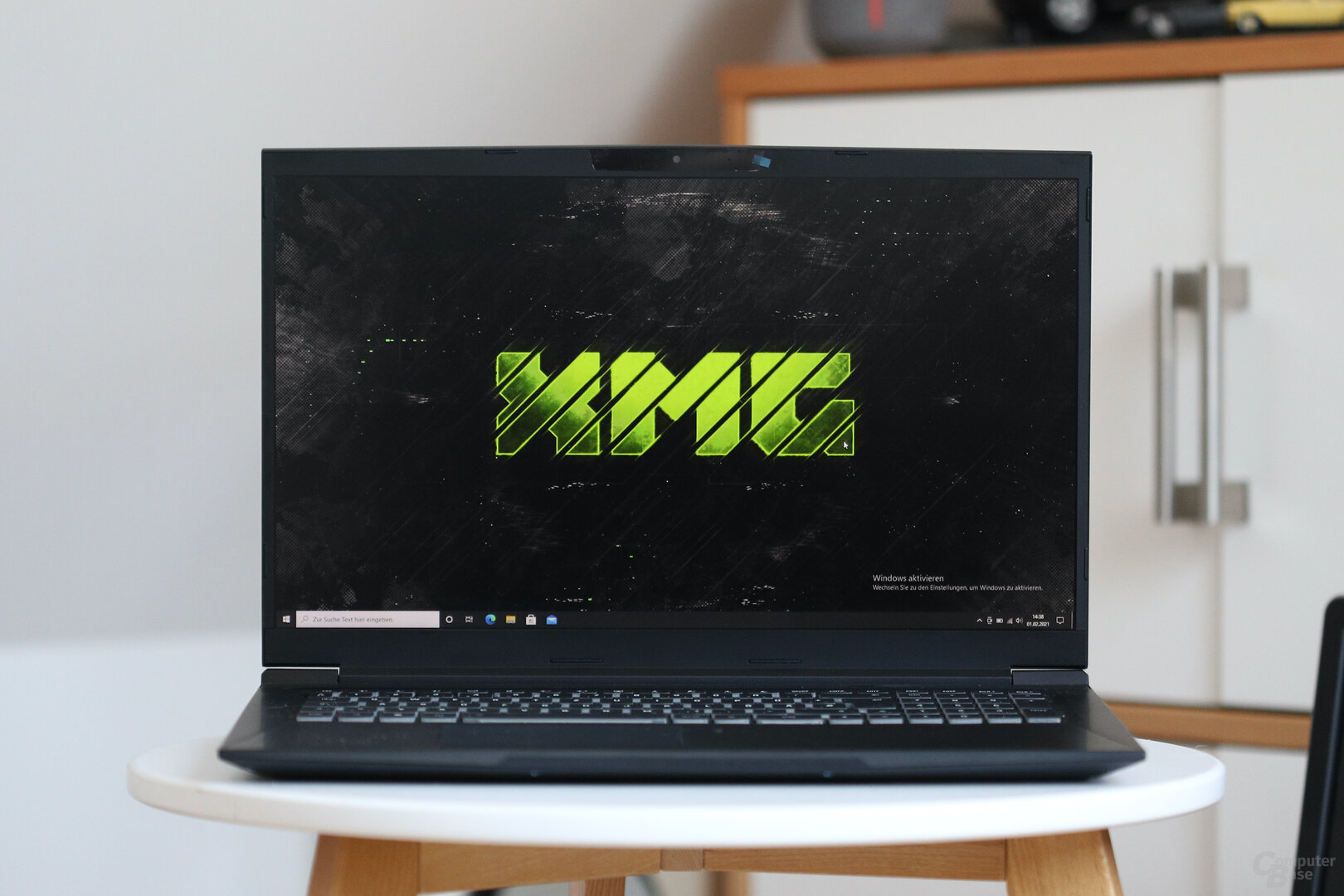 The XMG Core 17 with Ryzen 7 5800H and GeForce RTX 3060 laptop GPU (130 watts)
The XMG Core 17 with Ryzen 7 5800H and GeForce RTX 3060 laptop GPU (130 watts) Almost identical Zen 3 cores: Now in the notebook
AMD's new Ryzen 5000 Mobile (code name Cezanne), are technically a little closer to the desktop solutions Ryzen 5000 ( Test) (code name Vermeer) than the previous generation. Because the modifications to the core cache architecture from Zen 2 to Zen 3 are also having an effect in this area.
Even closer to Ryzen for desktop PCs
Above all, the native 8-core die plays into the cards of the new mobile solution. Instead of cutting 75 percent of the actually 16 MB L3 cache in each of the two quad-core CCXs, as was the case with Renoir, there is now only one halving in the new mobile 8-core CCX. The bottom line is that the L3 cache has been doubled for the APUs, but they are still not allowed to reach the full desktop level. The differences, which were already marginal last year, should, however, almost disappear in the background noise. As early as last year, AMD stated that the L3 cache had an extremely low impact on performance in this market environment. However, they shy away from full expansion because the cache eats up both energy and space.
More CPU clock (and TDP) means more performance
AMD promises up to 23 percent more performance in single-threaded applications from Ryzen 4000 to Ryzen 5000. But that's it By far not only due to Zen 3, as a look at the details reveals. The mobile top model Ryzen 9 5980HX with a TDP of 45 watts (and more) can now work with up to 4.8 GHz, last year's top model with 45 watts only with 4.4 GHz when one core is loaded.
In any case, the TDP design among partners and OEMs will be even more interesting this year than it was last time. Ultimately, AMD CPUs in notebooks have always been allowed to consume more than the TDP, but they have never been advertised so explicitly in advance. AMD describes it diplomatically as “45 watt plus”, the first announcements of notebooks already show that manufacturers will even send the solutions into the race with up to 80 and even 90 watts on request – the test model even offers 130 watts, which is the CPU but no longer knows how to use it.
At first glance, the numbers look far-fetched to laypeople, but they are by no means new and there is also enough experience: 80 watts peak load are the rule in Intel's H-model range in upper-class notebooks, Apple's 16-inch MacBook Pro left almost 90 Watts too, certain test samples were already on the move with over 100 watts. The CPUs are officially designed for chassis with a permanent 45 watt cooling capacity, but they can do more. More and more notebooks are also using it – ex works or on request via profiles.
Old Vega GPU with less voltage and more clock
AMD has overhauled the APU for the CPU, but this is not the case with the GPU. The Vega architecture, with its roots way back in the past of Graphics Core Next (GCN), has essentially remained the same, albeit in a newly optimized form. AMD has optimized the voltage and power supply of the GPU units in particular so that the ALUs can clock up to 20 percent higher without this having a significantly negative effect on consumption.
The now up to 2.1 GHz clock rate provides 2.15 GFLOPS of computing power in FP32 when the Vega8 is fully expanded. This looks good in theory, but in practice the gain in performance compared to its predecessor, Renoir, will only be minimal. If in the end you can get around 10 percent more power with 20 percent more clock, that should already mark the upper average. Ultimately, the growth from Ryzen 7 5800U to Ryzen 7 4800U is marginal even on AMD's own documents. The data determined by the editorial team later also show that, even behind Intel Xe in Tiger Lake, AMD's graphics now sometimes fall behind.
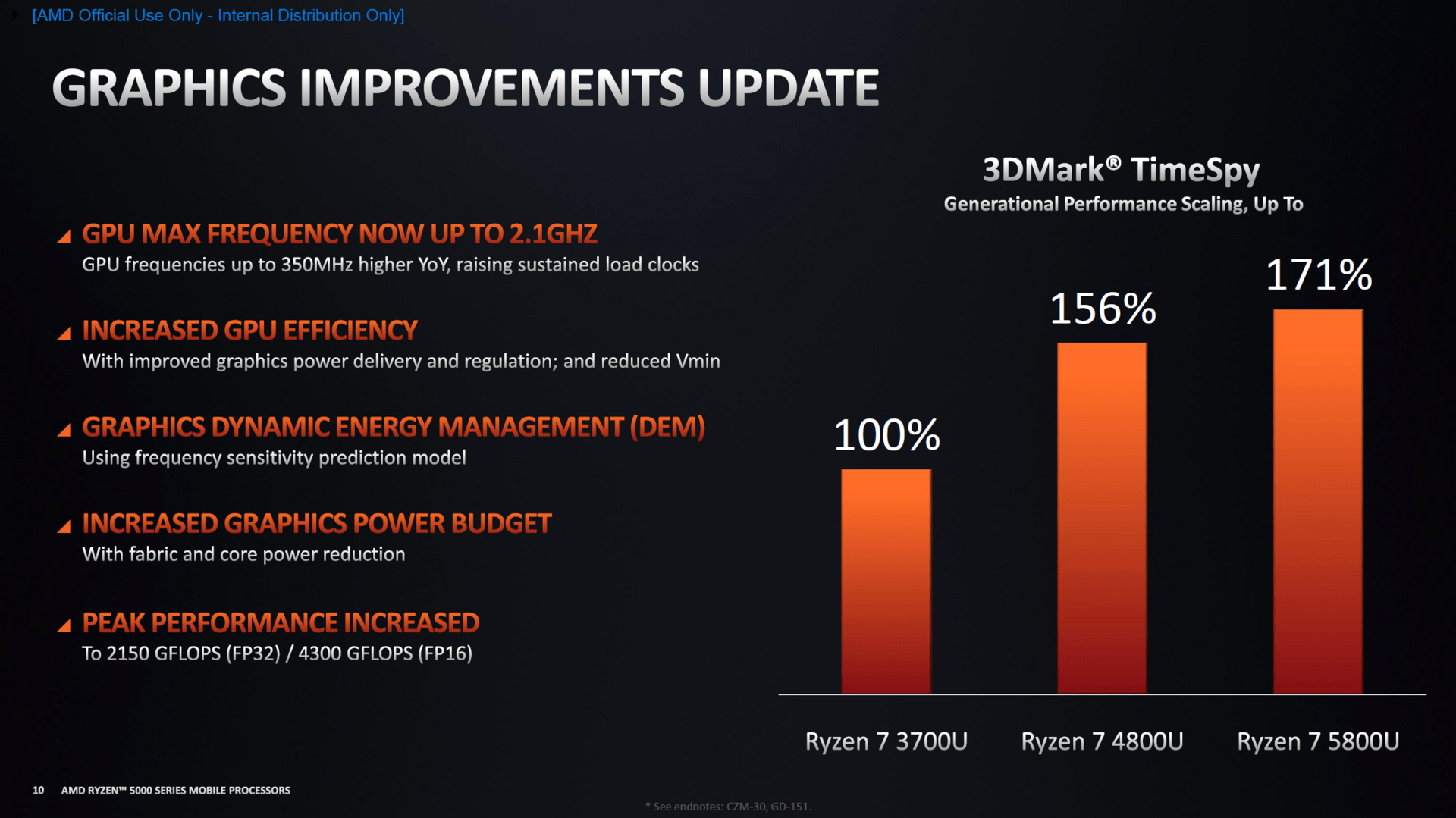 The graphics performance increases only slightly compared to Renoir (Image: AMD)
The graphics performance increases only slightly compared to Renoir (Image: AMD) Vega, with its roots in 2016, ultimately also means that the video decoder and encoder cannot go any further. While new GPUs from AMD with RDNA-2 architecture as well as Intel Xe and Nvidia Ampere can, for example, decode the video codec AV1 in hardware, AMD's APU in this generation still has to do without it (encoding does not yet master a GPU at the beginning of 2021). And in all other aspects, the video engine has not changed anything compared to Renoir.
AMD used to be a pioneer when it came to supporting new ideas in this area, and even the smallest APUs could offer more in these areas than any competing product. AMD has currently given up this lead in favor of the CPU performance, which is particularly bitter for the U series: With eight state-of-the-art CPU cores, the notebook will certainly do well for five years, but the graphics part will soon be ten years old. After all: In the H series, Cezanne should usually be coupled with a dedicated GPU that supports the AV1 codec with Ampere or RDNA 2.
The memory also saves more electricity
Serving memory to and from a CPU and GPU is extremely power hungry. A lot of energy can therefore be saved with the memory PHY and over short distances with a suitable RAM. For this reason, Apple uses the same package for the memory of the M1: the closer, the more efficient. AMD cannot go that way today, but it is optimizing the classic ways. According to its own information, AMD was able to save around 20 percent in this way. The recommendation is of course to use energy-saving but soldered LPDDR4, although a large number of notebooks will continue to appear with classic DDR4 in a socketable SO-DIMM form, which is, however, less efficient.
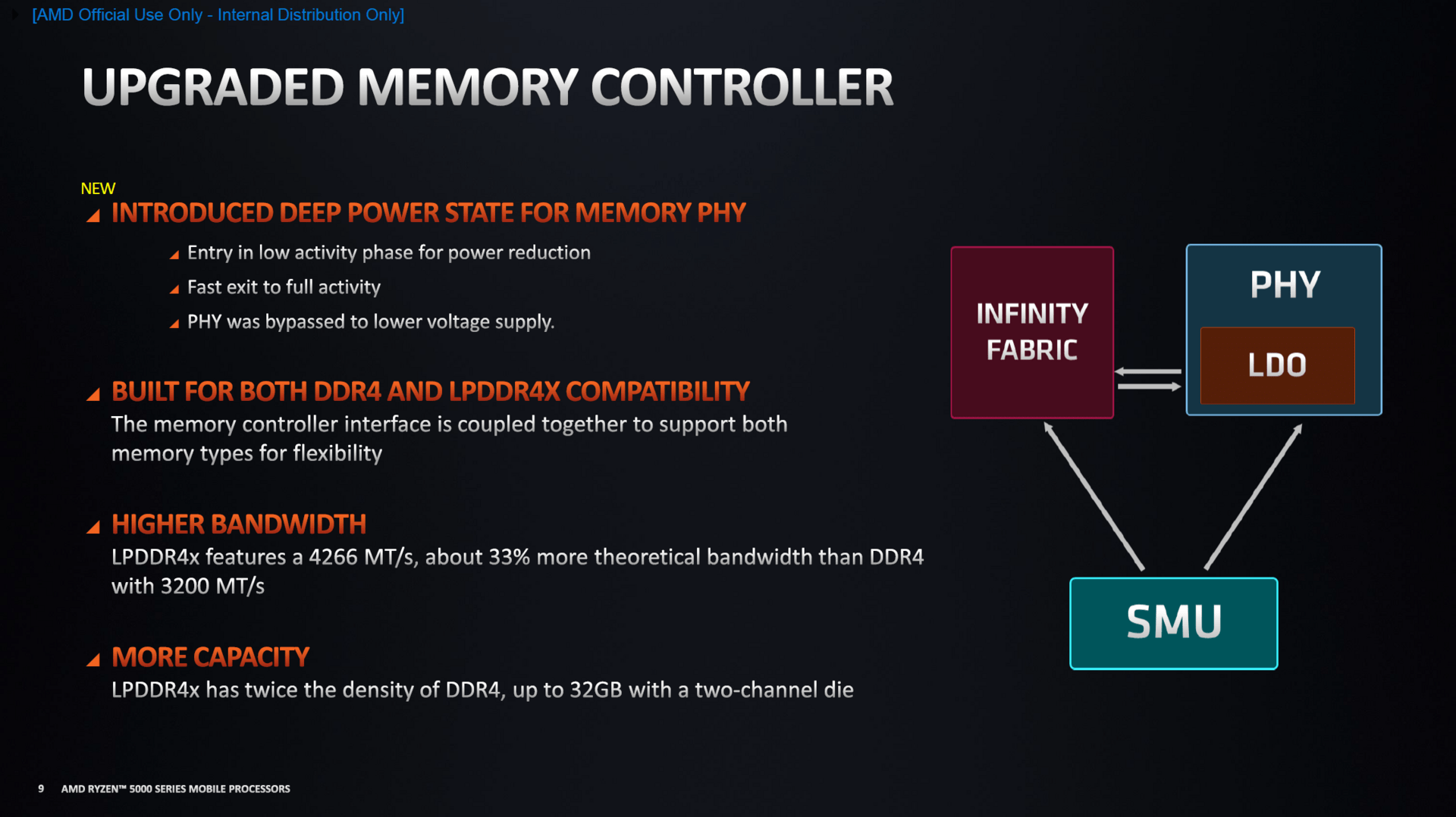 Upgraded memory controller saves electricity (Image: AMD)
Upgraded memory controller saves electricity (Image: AMD) The performance can be seen as expected. It is not completely on par with the desktop solutions from Ryzen 5000 with the same number of cores, which is due to the slightly lower average clock rate and poorer timing of the memory with its very high latency. However, the L1 and L2 values show that the Ryzen 5000 all belong to one family. The bandwidth of the RAM is even higher when writing in the notebook than in the desktop – the advantage of LPDDR4 becomes visible.
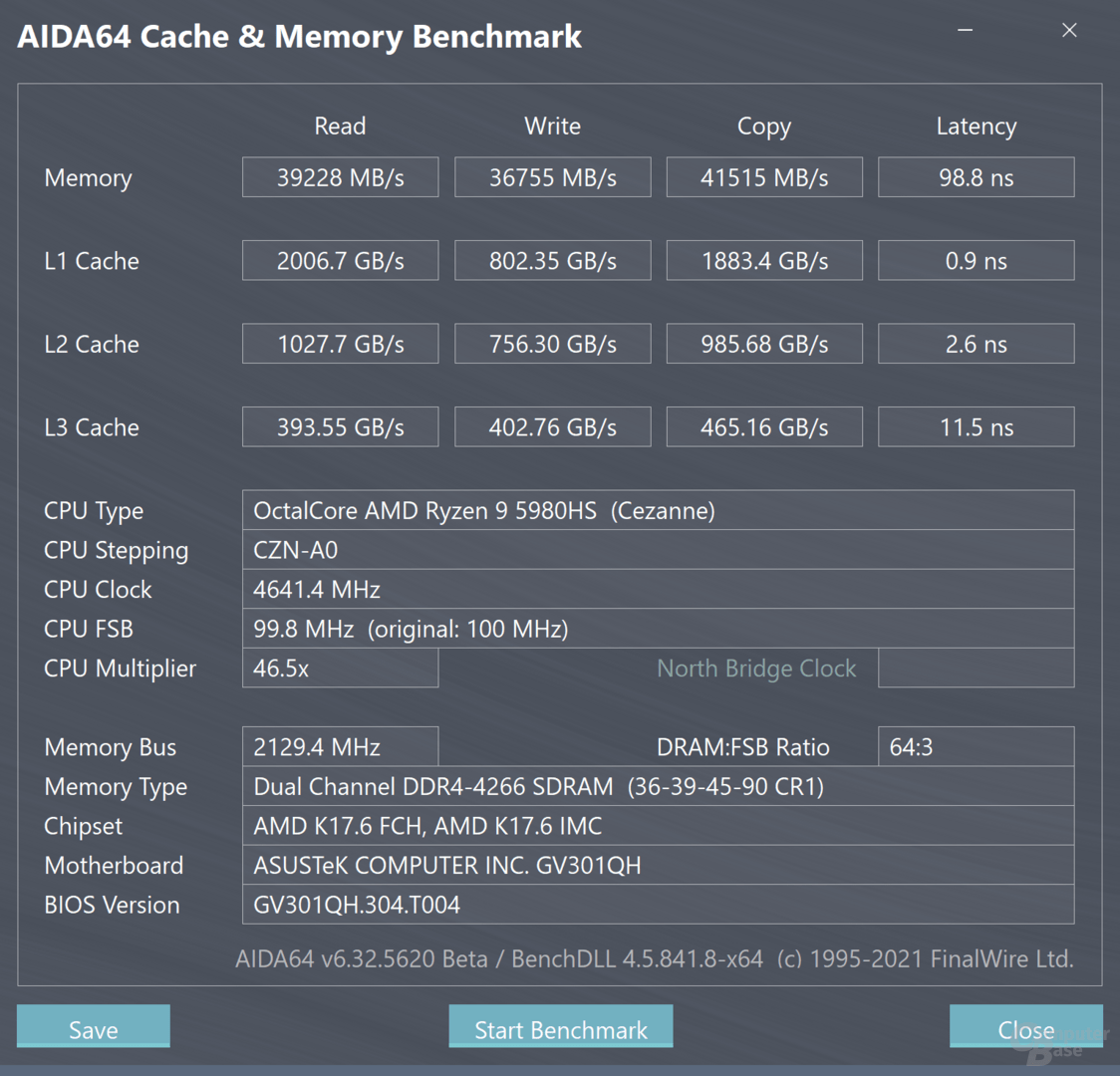 AMD Ryzen 9 5980HS in the memory test
AMD Ryzen 9 5980HS in the memory test  For comparison: Ryzen 7 5800X
For comparison: Ryzen 7 5800X Still only eight PCIe 3.0 lanes for graphics cards
The chipset integrated into the SoC, called “Fusion Controller Hub” (FCH) by AMD, has also not changed compared to Renoir. In 2021, even for the now extremely powerful processors, there will be eight PCI Express 3.0 lanes for graphics cards, which will put the manufacturer behind Tiger Lake H45. Not only do all new graphics chips now support PCI Express 4.0 natively, Intel's 8-core will even be able to address these in the notebook with a full 16 PCIe 4.0 lanes and thus provide four times the bandwidth compared to AMD solutions on paper. This will not allow an exorbitant increase in performance, but can contribute a few percent in some places. Four more PCIe lanes are provided for M.2 SSD – but no OEM can use PCIe 4.0 SSDs for advertising purposes.
The I/O equipment is rounded off by up to four ports in accordance with the USB 3.2 Gen2 standard with 10 Gbps, four classic USB 2.0 ports and four SATA. In this area, too, Intel is now more clearly in the lead: In addition to Thunderbolt 4 (USB 4.0), there is PCI Express 4.0 for M.2. The lead achieved in the desktop, where AMD was a pioneer in PCI Express 4.0 and more, can be more than sharpened in the notebook overall.
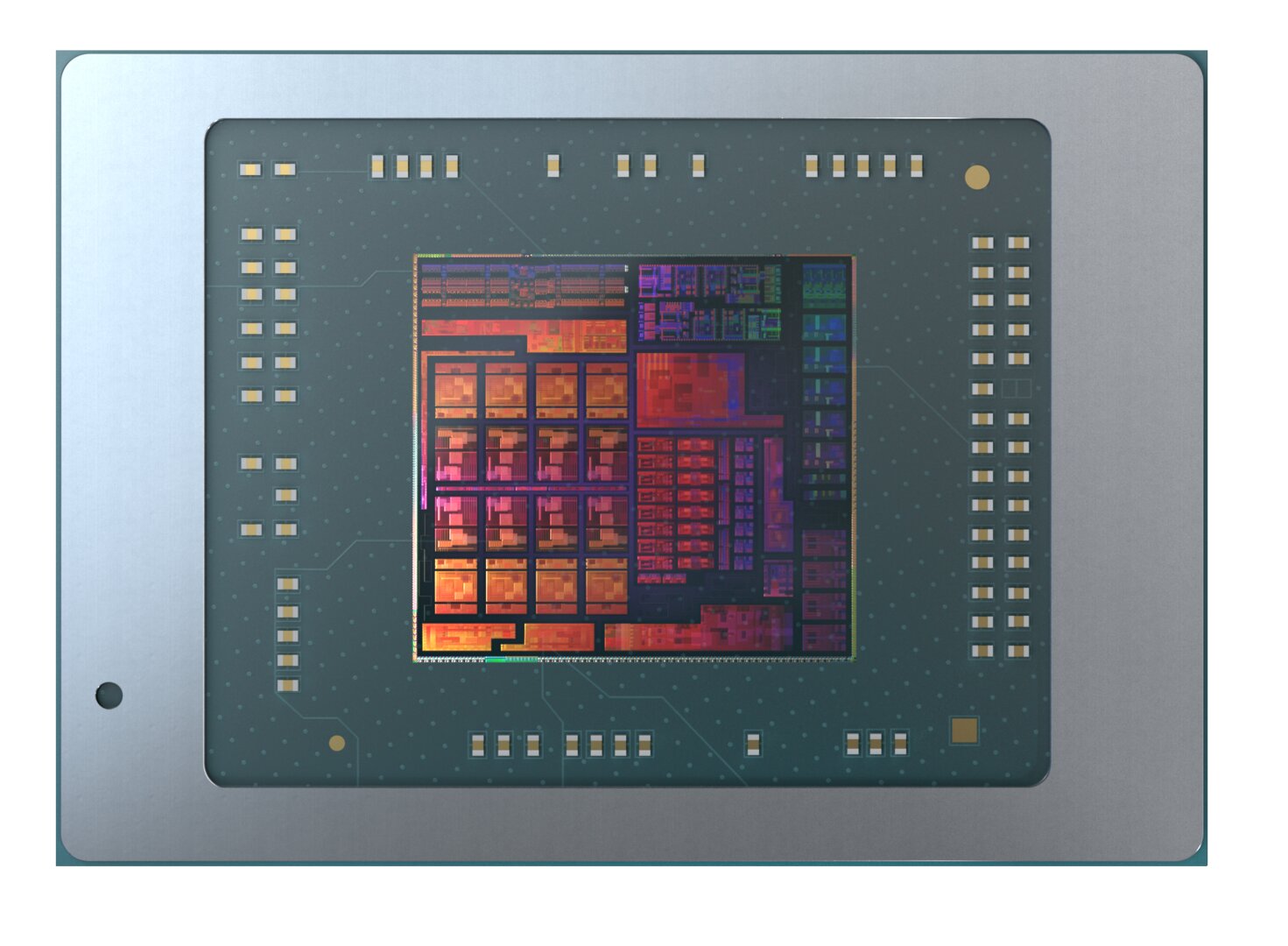 AMD Cezanne alias Ryzen 5000 Mobile – Die on Chip ( Image: AMD)
AMD Cezanne alias Ryzen 5000 Mobile – Die on Chip ( Image: AMD) The APU has grown, but uses the same base
Since the predecessor at TSMC in 7 nm was manufactured, the technical advances in the CPU not only require more transistors, but also more space. The die area of Renoir compared to Cezanne grows from 156 to 180 mm², because instead of 9.8 billion transistors the package is now 10.7 billion transistors heavy.
The BGA socket FP6 with the dimensions 25 × 35 × 1.38 mm is still being continued, which should enable OEMs to easily switch to the new solutions with their previous boards: Renoir and Cezanne are “pin-compatible”. This should also be evident in retail – the start should be much more fluid, AMD promised in January.
Closer to Intel when it comes to power consumption
Last year, AMD confirmed in a conversation that Renoir is not yet where Intel was in terms of power consumption, especially in idle and standby. The focus with Cezanne therefore went extremely in this direction, as can be seen in many sub-areas, and will make a difference in idle consumption in particular. Cezanne is there compared to Renoir at only 53 percent of the initial value. According to AMD, this can provide an additional four hours of battery life. When working, the mixture of load and idle, it should be two hours more. And even watching videos, you can still win an hour.
These criteria could make the last doubters switch, especially in the U area. Because in many cases there is already more than enough performance, but there was still a lack of runtime.
-
 Significantly longer runtime from one battery charge (Image: AMD)
Significantly longer runtime from one battery charge (Image: AMD)
Image 1 of 4
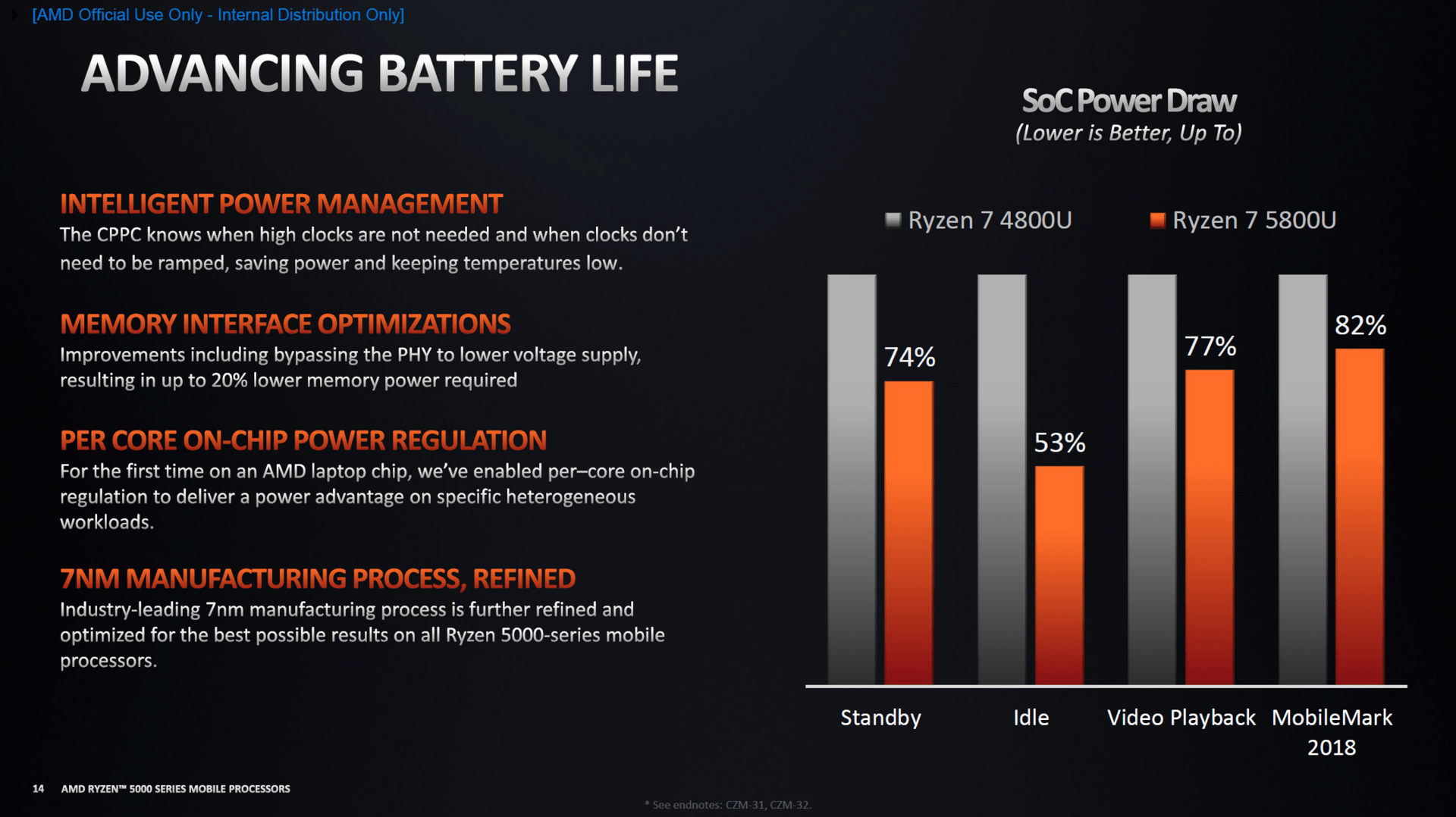 Significantly longer runtime from one battery charge
Significantly longer runtime from one battery charge 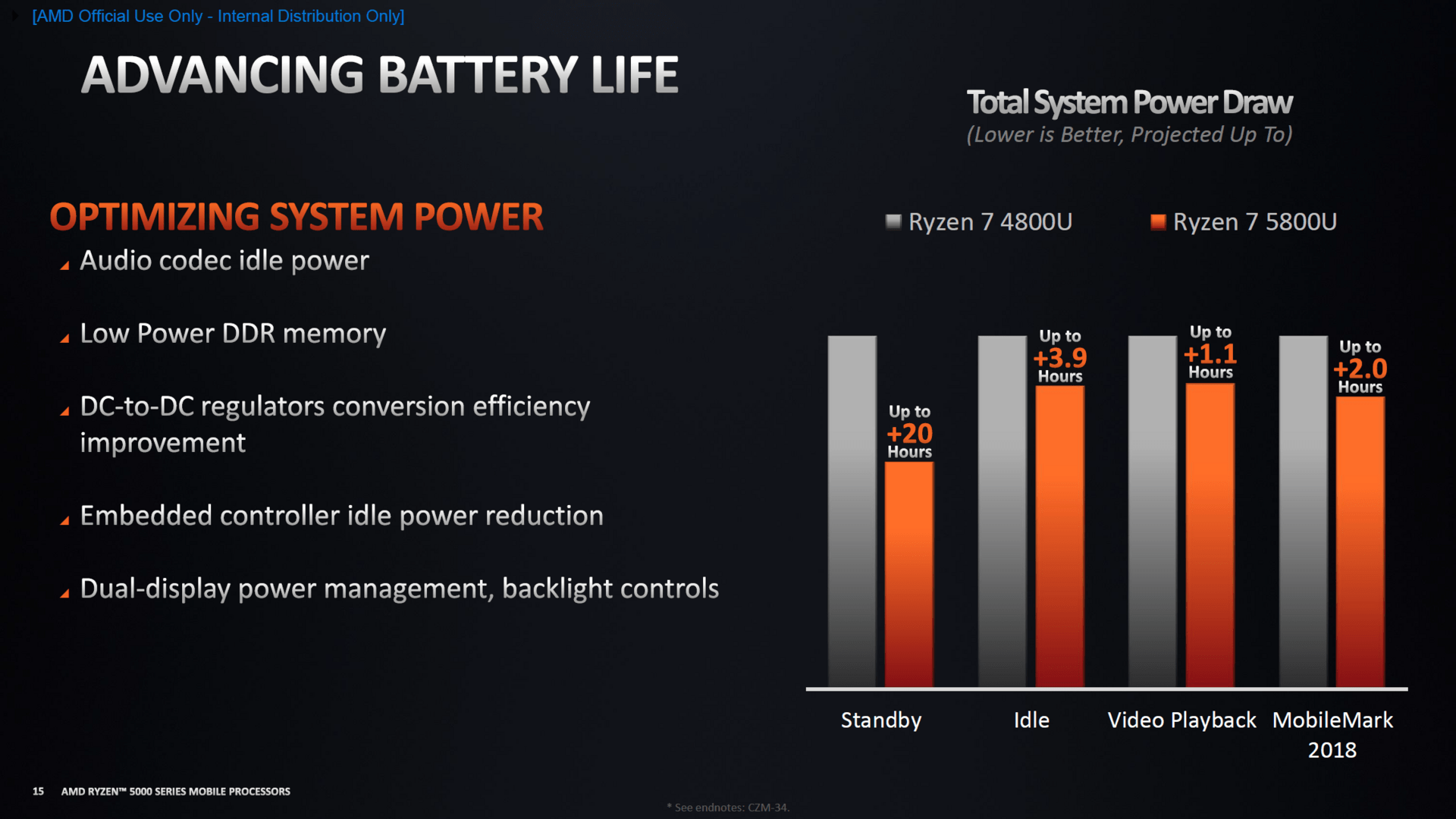 Significantly longer runtime from one battery charge 2
Significantly longer runtime from one battery charge 2 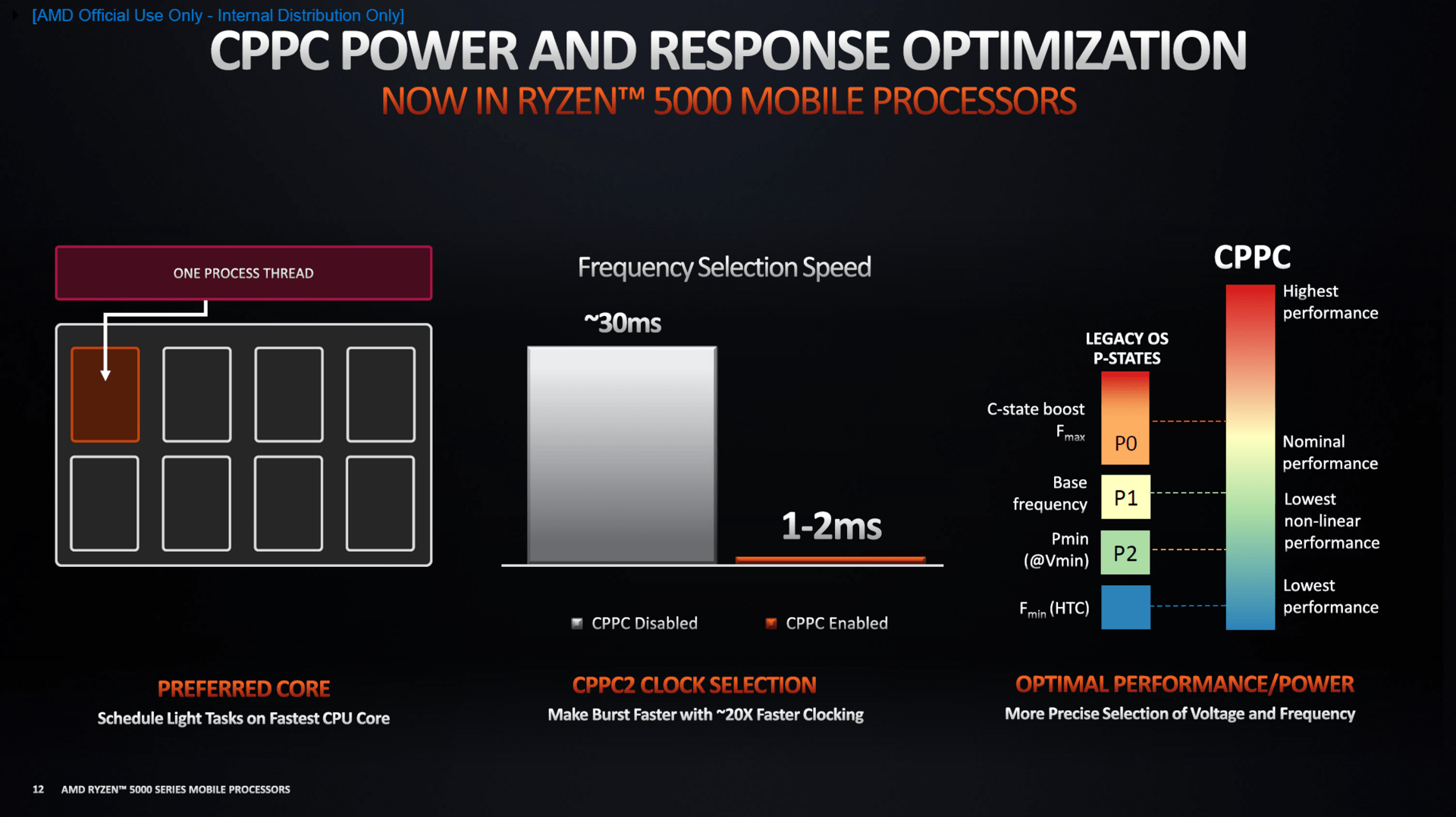 CPPC from the desktop now also in the notebook
CPPC from the desktop now also in the notebook In the end, however, theory still stands in the way of practice. Here notebook manufacturers are called upon to face the issue and equip AMD notebooks with competitively large batteries. The AMD Ryzen 4000 occasionally got stuck.
Model range of AMD Ryzen 5000 Mobile
Why does the Ryzen 5000 portfolio in the notebook look like AMD presented it? After some astonishment, the company responded to this question at the start, because the differences to the Ryzen 4000 are noticeable. The focus is now clearly on the H series with 35 or 45 watts, last year's HS experiment with 35 watts is being expanded. But the U series is not as small as announced at the beginning. AMD quickly added another model.
The model range is largely due to the development of the past year. As a result of the corona crisis, the notebook segment grew by an incredible 156 percent, explains AMD, the solutions replace entire workstations or PCs there. And the calls for more home offices tend to increase rather than decrease even a year later. The notebook shoulders a large part of this development. And the answer for many is not automatically a light and thin device, which the U series stands for, but a “classic” all-rounder, as the 15.6-inch notebook has always been and is still the market leader in many areas today .
The 5000 series is not intended to be just the H series, however. AMD emphasizes that the series is even more scalable than before, the SKUs interlocking, especially in the border areas. From 12 watt solutions as the most energy-saving variant of the U series to 54 watts and beyond as an HX model, there is a solution from AMD. SMT is always the rule – one step forward with various models.
Lucienne is more like Cezanne Light than Renoir Refresh
Zen 2 is not dead: the old kernels live on in Lucienne. However, Lucienne is a pure OEM product that is primarily intended to expand AMD's market presence. The price plays an important role there, which according to the manufacturer justifies the continued use of Zen 2.
But Lucienne is not just a Renoir 2.0. According to AMD, it is more of a Cezanne, except that Zen 2 is used instead of Zen 3 CPU cores, while the other components are at Cezanne level. The completely new power management for CPU and GPU and also the memory is included, higher clock rates and always SMT as well. So Lucienne is more Cezanne Light than Renoir Refresh.
Threads Base clock Turbo clock Graphics Graphics clock L3 cache TDP Ryzen 5000H Ryzen 9 5980HX Cezanne (Zen 3) 8/16 3.30 GHz 4.80 GHz Vega8 2.1 GHz 16 MByte 45+ watt Ryzen 9 5980HS 3.00 GHz 4.80 GHz 35 watt Ryzen 9 5900HX 3.30 GHz 4.60 GHz 45+ watt Ryzen 9 5900HS 3.00 GHz 4.60 GHz 35 watt Ryzen 7 5800H 3.20 GHz 4.40 GHz 2.0 GHz 45 watt Ryzen 7 5800HS 2.80 GHz 4.40 GHz 35 watt Ryzen 7 5700H * – 45 watt Ryzen 5 5600H 6/12 3.30 GHz 4.20 GHz Vega7 1.8 GHz 45 watt Ryzen 5 5600HS 3.00 GHz 4.20 GHz 35 Watt Ryzen 5000U Ryzen 7 5800U Cezanne (Zen 3) 8/16 1.90 GHz 4.40 GHz Vega8 2,000 MHz 16 MByte 15 Watt Ryzen 7 5700U Lucienne (Zen 2) 1.80 GHz 4.30 GHz 1.900 MHz 8 MByte 15 Watt Ryzen 5 5600U Cezanne (Zen 3) 6/12 2.30 GHz 4.20 GHz Vega7 1,800 MHz 16 MByte 15 Watt Ryzen 5 5500U Lucienne (Zen 2) 2.10 GHz 4.00 GHz 1,800 MHz 8 MByte 15 Watt Ryzen 3 5400U ** Cezanne (Zen 3) 4/8 2.60 GHz 4.00 GHz Vega6 1,600 MHz 8 MByte 15 Watt Ryzen 3 5300U Lucienne (Zen 2) 2.60 GHz 3.80 GHz 1,500 MHz 4 MByte 15 Watt * unconfirmed gt, but already named by notebook manufacturers
** subsequently confirmed by AMD as “Limited Volume SKU”
In addition to the U and H series, there will also be Pro versions for the business environment later this year. Most recently, these were located very close to the existing models, which can be assumed for the first time this year as well, as the first sightings at large OEMs confirm. Together, the three product groups should be able to produce 150 different notebooks this year and next, hopes AMD. It would be a plus of 50 percent compared to the Renoir generation.
-
 Pro models will follow shortly (Image: AMD)
Pro models will follow shortly (Image: AMD)
Image 1 of 2
 Pro models will follow shortly
Pro models will follow shortly 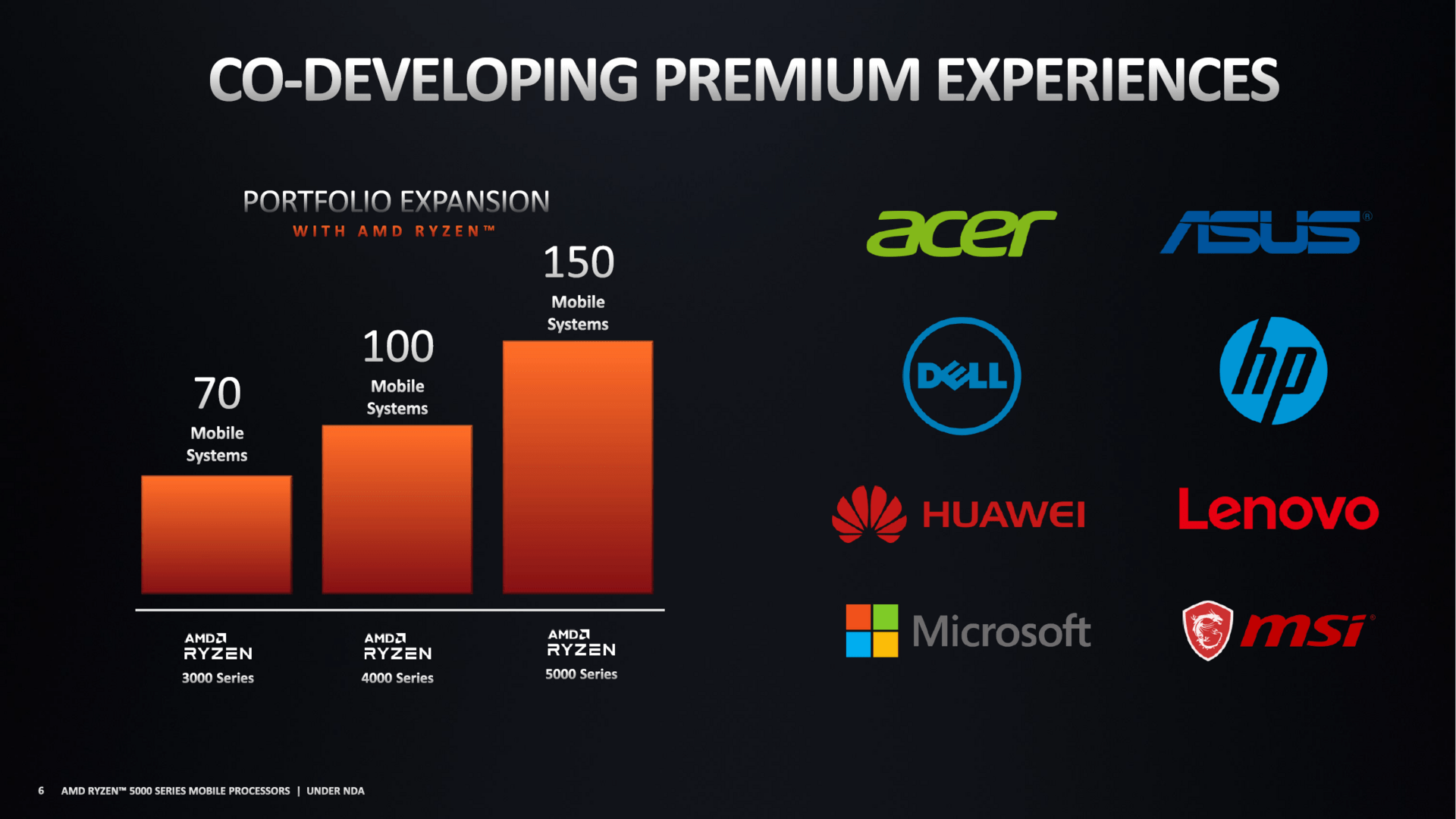 150 models targeted
150 models targeted On the next page: test results and benchmarks